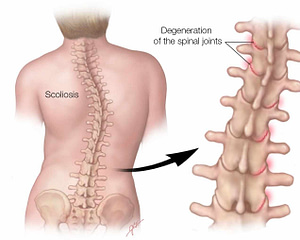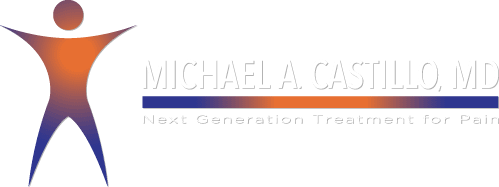Scoliosis is any abnormal sideways curvature of the spine measuring at least 10 degrees on an x-ray. While it’s not a disease, in rare cases it can be caused by a disease. More often, however, scoliosis develops from an unknown cause during adolescence or from spinal degeneration during adulthood.
 Structural vs. Nonstructural
Structural vs. Nonstructural
There are two general categories for scoliosis:
- Structural is by far the most common category of scoliosis. It involves spinal rotation in addition to the side-to-side curvature of the spine. This type can affect the spine’s structure and is considered permanent unless the spine receives treatment.
- Nonstructural, also known as functional scoliosis, results from a temporary cause and only involves a side-to-side curvature of the spine (no spinal rotation). The spine’s structure is still normal.
If a person with nonstructural scoliosis were to bend forward or lay down, the spinal curve would likely go away while held in that position.
Structural scoliosis is typically considered more serious because it does not straighten out on its own and can potentially result in more spinal deformity.
Types of Structural Scoliosis
There are several types of structural scoliosis, including:
- Idiopathic accounts for about 8 in 10 cases of scoliosis. This type can typically presents during adolescence, but it can also start earlier in childhood or infancy. What causes idiopathic scoliosis is currently unknown. Some research indicates genetics plays a part, but other factors are also likely involved and continue to be studied.
- Degenerative (adult scoliosis is a common condition that occurs later in life as the joints in the spine degenerate. Read more about adult scoliosis.
- Neuromuscular sometimes develops in individuals who cannot walk due to a neuromuscular condition such as muscular dystrophy or cerebral palsy. This type can may also be called myopathic scoliosis.
- Congenital develops in utero and is present in infancy. A rare condition, affecting 1 in 10,000, it can result from malformations in the vertebrae or other causes. In most cases the spinal curve must be corrected surgically.
Rarely, is it caused by a spinal lesion or tumor. Usually, patients who are younger (age 8 to 11) than typical scoliosis patients will experience symptoms such as pain, numbness and a left-curving thoracic spine. A physician who sees any or a combination of these symptoms will order additional diagnostic tests, such as an MRI, to rule out the possibility of spinal tumor or other lesions as a cause of scoliosis.
By Ali Baaj, MD
Updated: 10/05/2017
Click to read more of the full article from Spine Health.

